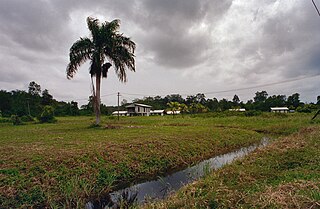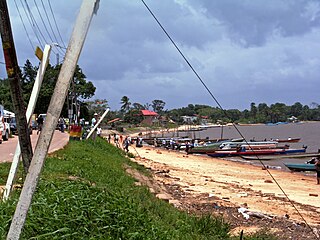Related Research Articles

Fort Zeelandia is a fortress in Paramaribo, Suriname. In 1640 the French built a wooden fort on the spot which, during British colonial period, was reinforced and became Fort Willoughby. It was taken by the Dutch in 1667 and renamed Fort Zeelandia.

Commewijne is a district of Suriname, located on the right bank of the Suriname River. Commewijne's capital city is Nieuw Amsterdam. Tamanredjo is another major town, while Meerzorg is the most populated.

Marowijne is a district of Suriname, located on the north-east coast. Marowijne's capital city is Albina, with other towns including Moengo and Wanhatti. The district borders the Atlantic Ocean to the north, French Guiana to the east, the Surinamese district of Sipaliwini to the south, and the Surinamese districts of Commewijne and Para to the west.

Moengo is a town in Suriname, located in the Marowijne district, between Paramaribo and the border town Albina on the Cottica River. Moengo is also a resort (municipality) in the district of Marowijne. Moengo was the capital of Marowijne District between 1932 and 1945. The current capital is Albina.

Nieuw Amsterdam is the capital of the Commewijne District in Suriname. It is a small coastal town situated at the confluence of the Suriname River and Commewijne River, just across from Paramaribo, the country's capital. Its population at the 2012 census was 5,650, with around 1,200 people living in the main town, most of whom are of Javanese and East Indian origin. It is the location of the historical Fort Nieuw-Amsterdam, today an open-air museum. The town of Mariënburg with former sugarcane factory is located 3 km from Nieuw Amsterdam and part of the resort.
Indo-Surinamese, Indian-Surinamese or Hindustani Surinamese are nationals of Suriname who trace their ancestry to the Indian subcontinent. Their ancestors were indentured labourers brought by the Dutch and the British to the Dutch colony of Suriname, beginning in 1873 and continuing during the British Raj. Per the 2012 Census of Suriname, 148,443 citizens of Suriname are of Indo-Surinamese origin, constituting 27.4% of the total population, making them the largest ethnic group in Suriname on an individual level.

Meerzorg is a town and resort (municipality) in Suriname, located on the eastern bank of the Suriname River, directly opposite the capital Paramaribo. Its population at the 2012 census was 12,405. Since 2000 it has been connected to Paramaribo by the Jules Wijdenbosch Bridge, named after the former President Jules Wijdenbosch.

The Ndyuka people or Aukan people (Okanisi), are one of six Maroon peoples in the Republic of Suriname and one of the Maroon peoples in French Guiana. The Aukan or Ndyuka speak the Ndyuka language. They are subdivided into the Opu, who live upstream of the Tapanahony River in the Tapanahony resort of southeastern Suriname, and the Bilo, who live downstream of that river in Marowijne District.

Ronnie Brunswijk is a Surinamese politician, businessman, former rebel leader, footballer and convicted drug trafficker, who is serving as the current Vice President of Suriname.

The Surinaams Museum is a museum located at Abraham Crijnssenweg 1 in Fort Zeelandia, Paramaribo, Suriname.

Surinamese Maroons are the descendants of enslaved Africans that escaped from the plantations and settled in the inland of Suriname. The Surinamese Maroon culture is one of the best-preserved pieces of cultural heritage outside of Africa. Colonial warfare, land grabs, natural disasters and migration have marked Maroon history. In Suriname six Maroon groups — or tribes — can be distinguished from each other.

Fort Nieuw-Amsterdam is a fort in Suriname built from 1734 to 1747 at the confluence of the Suriname and Commewijne rivers. It is open to the public as an open-air museum.

Braamspunt is a nature reserve, fishing village, and a former military outpost in the Johan & Margaretha resort of the Commewijne District of Suriname. Braamspunt is the most western point of the Commewijne District at the combined mouth of the Suriname and Commewijne River. The capital Paramaribo is located to the south of Braamspunt. The name is a corruption of Byam's Point which refers William Byam who was a quartermaster of Willoughby.

Ovia Olo, also Ovillanhollo, is a village of Ndyuka Maroons in the Patamacca resort of the Marowijne District of Suriname.

Johannes François Adriaan Cateau van Rosevelt was a Dutch navy officer and civil servant in Suriname where he was, among other things, agent-general for immigration and a member of the Colonial Estates of Suriname. He is known for his map of Suriname.
Lalla Rookh Museum is a museum about the Indo-Surinamese history and culture. It is located in the Lalla Rookh Complex in Paramaribo, Suriname.

Dance in Suriname is practiced from the amateur to the professional level for cultural, social and spiritual reasons, among others. Suriname has a variety of traditional and contemporary dance styles which have developed from the cultures of its ethnic groups. In addition, several foreign popular styles have been adopted from the West, the greater Caribbean, Java and Bollywood.

Fort Sommelsdijk was a fort in Suriname built in 1686 at the confluence of the Commewijne and Cottica rivers. Later it was used as a mission post and hospital. In 1870, it lost its function and was only used a military outpost. In the 21st century, the fort was taken over by nature.

Christiaan Hendrik "Hein" Eersel was a Surinamese linguist and cultural researcher.
References
- ↑ Koto Museum: koto’s en herleving van herinneringen. Caraïbisch uitzicht, Werkgroep Caraïbische letteren. (in Dutch)
- ↑ Lalla Rookh Museum. lallarookh.org. (in Dutch)
- ↑ Murphy, Janet (30 April 2016). "Lalla Rookh- Marking the Indian Arrival in Suriname". NewsGram. Retrieved 23 January 2021.
- ↑ Gupta, Jayanta (26 November 2017). "Suriname envoy at Kolkata ghat from where ancestors set sail - Kolkata News". The Times of India. Retrieved 24 January 2021.
- ↑ Suriname krijgt scheepvaartmuseum. Historisch Nieuwsblad, 3 April 2002. (in Dutch)
- ↑ Numismatisch Museum. Centrale Bank van Suriname. (in Dutch)
- ↑ The Stichting Surinaams Museum. amazonian-museum-network.org. (in Dutch)
- ↑ Het Surinaamsch Rumhuis. rumhuis.sr. (in Dutch)
- ↑ Over Villa Zapakara. villazapakara.com(in Dutch)
- ↑ "Fort Nieuw-Amsterdam". fortnieuwamsterdam.sr (in Dutch). Archived from the original on 7 November 2013.
- ↑ Fort Nieuw-Amsterdam in Suriname staat op omvallen. Het Parool, 11 May 2018. (in Dutch)
- ↑ Museum van Bakkie. warappakreek.com. (in Dutch)
- ↑ "Telecom Museum". fortnieuwamsterdam.sr (in Dutch). Archived from the original on 7 November 2013.
- ↑ Telecommunicatie museum in Nieuw-Amsterdam. nospang.com. (in Dutch)
- ↑ Coronie heeft Mangrove Educatie Centrum. starnieuws.com, 16 October 2015. (in Dutch)
- ↑ Moengo krijgt een Contemporary Art Museum, de Ware Tijd, 20 July 2011. (in Dutch)
- ↑ Saamaka Marronmuseum. Cultuur & heritage in het regenwoud van Suriname. (in Dutch)